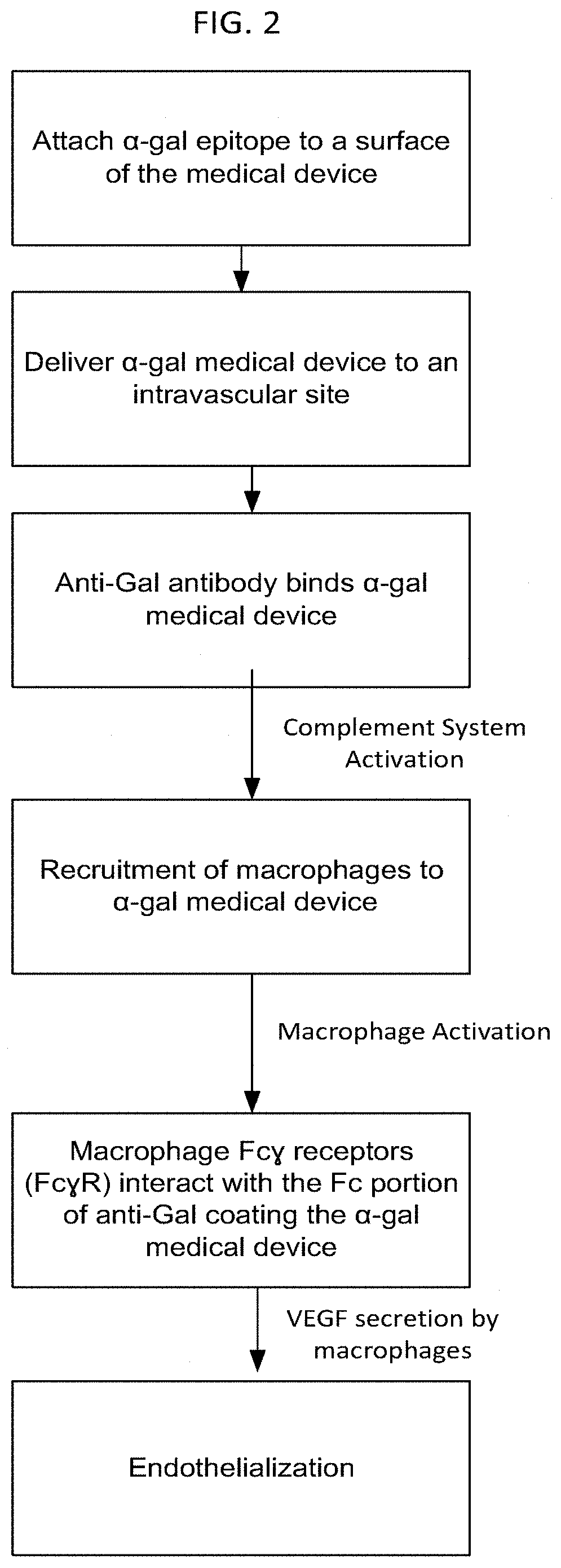Methods for Enhanced Endothelialization of Implanted Material
a technology of endothelialization and implanted materials, which is applied in the field of cardiac and vascular surgery, can solve the problems of large luminal area of prosthetic vascular grafts remaining without endothelium, significant increase in the risk of thrombosis, and the greatest risk of thrombosis, and achieve the effect of increasing endothelialization
- Summary
- Abstract
- Description
- Claims
- Application Information
AI Technical Summary
Benefits of technology
Problems solved by technology
Method used
Image
Examples
example 1
[0050]Exemplary α-gal epitopes are generated from extracts of rabbit red blood cell (RBC) membranes. These membranes are used since they contain glycolipids carrying from one to more than seven α-gal epitopes per molecule as disclosed in Eto et al., Biochem. (Tokyo) 64, 205, (1968); Stellner et al., Arch. Biochem. Biophys. 133, 464 (1973); Dabrowski et al., J. Biol. Chem. 259, 7648 (1984) and Hanfland et al., Carbohydr. Res. 178, 1 (1988), all of which are hereby incorporated by reference. However, α-gal epitopes may be produced from any natural or synthetic source of α-gal epitopes and may include the addition of phospholipids in the presence or absence of cholesterol, after processing as described herein. As a non-limiting example, rabbit RBC are used at a volume of 0.25 liter packed cells. The RBC are lysed by repeated washes with distilled water. The rabbit RBC membranes are then mixed with a solution of 600 ml chloroform and 900 ml methanol for 20 h with constant stirring to di...
example 2
[0051]In some embodiments, human or rabbit or bovine RBC may be used as a source of α-gal epitopes. Isolation of α-gal epitopes from rabbit RBC are used by way of non-limiting example herein. Batches of 1 liter rabbit RBC were lysed in water and washed repeatedly to remove hemoglobin. For the extraction process, rabbit RBC membranes (RBC ghosts) were mixed with 1000 ml chloroform and 1000 ml methanol (1:1 chloroform:methanol) for 2 h, then 1000 ml methanol was added for overnight incubation with constant stirring (1:2 chloroform:methanol). The extract was filtered under vacuum through Whatman filter paper for removing residual RBC membranes and precipitated proteins. For use for attaching the α-gal epitopes to a medical device, the isolated α-gal epitopes will be resuspended in a solution suitable for attaching to the medical device. The α-gal epitope suspension will be sterile because all proteins were denatured and removed in the chloroform:methanol extraction process.
example 3
[0052]In some embodiments, α-gal glycolipids may be used, for example from human, bovine or rabbit sources. By way of non-limiting example a rabbit source of α-gal glycolipids is described herein. A rich source for α-gal glycolipids is rabbit red blood cells. The two major glycosphingolipids (GSL), i.e. glycolipids with ceramide tail, in rabbit red blood cell membranes are ceramide (Cer) trihexoside (CTH, with 3 sugars [hexoses], present also in human red blood cells) with the structure Galα1-4Galβ1-4Glc-Cer and ceramide pentahexoside (CPH, with 5 sugars [hexoses]) with α-gal epitopes as terminal part of the CPH structure of Galα1-3Galβ1-4GlcNAcβ1-3Galβ1-4Glc-Cer (Eto T, Iichikawa Y, Nishimura K, Ando S, Yamakawa T J. Biochem. (Tokyo) 1968; 64: 205-13, and Stellner K, Saito H, Hakomori S. Arch. Biochem. Biophys. 1973; 133: 464-72) (See FIG. 1 and FIG. 6A, lane 1). Immunostaining of rabbit α-gal glycolipids on thin layer chromatography (TLC) plates with human natural anti-Gal resulte...
PUM
| Property | Measurement | Unit |
|---|---|---|
| size | aaaaa | aaaaa |
| diameter | aaaaa | aaaaa |
| diameter | aaaaa | aaaaa |
Abstract
Description
Claims
Application Information
 Login to View More
Login to View More - R&D
- Intellectual Property
- Life Sciences
- Materials
- Tech Scout
- Unparalleled Data Quality
- Higher Quality Content
- 60% Fewer Hallucinations
Browse by: Latest US Patents, China's latest patents, Technical Efficacy Thesaurus, Application Domain, Technology Topic, Popular Technical Reports.
© 2025 PatSnap. All rights reserved.Legal|Privacy policy|Modern Slavery Act Transparency Statement|Sitemap|About US| Contact US: help@patsnap.com


